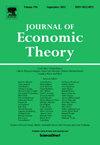Public goods, social alternatives, and the Lindahl-VCG relationship
IF 1.2
3区 经济学
Q3 ECONOMICS
引用次数: 0
Abstract
Lindahl prices, set by a fictitious auctioneer with full knowledge of values and costs, are a generalization of Walrasian prices. By making the efficient allocation utility- and profit-maximizing for all players, they induce an efficient outcome in a decentralized way even in the presence of public goods. We study a collective choice model with quasilinear utility, which encompasses the allocation of public and private goods as special cases. We show that each agent's most favorable Lindahl payment (the smallest Lindahl price for the efficient alternative) is equal to his VCG transfer while the firm's VCG transfer is equal to its most favorable Lindahl payment (the largest sum of Lindahl prices for the efficient alternative). Thus, the VCG mechanism incurs a deficit if and only if the set of vectors of the agents' Lindahl payments is multi-valued. Unlike Walrasian prices, Lindahl prices are not restricted to be anonymous or additive. This is the reason why, when considering the allocation of private goods, the agents' smallest Walrasian payments are at least as large as their most favorable Lindahl payments, and thus their VCG transfers. It is also why Lindahl prices always exist while Walrasian prices may not.
公共产品,社会选择,和林达尔- vcg关系
林达尔价格是由一个虚构的拍卖师设定的,他对价值和成本有充分的了解,是瓦尔拉斯价格的概括。通过对所有参与者进行效用和利润最大化的有效分配,即使在存在公共产品的情况下,它们也以分散的方式诱导出有效的结果。我们研究了一个具有拟线性效用的集体选择模型,该模型将公共物品和私人物品的分配作为特例。我们证明了每个代理人最有利的林达尔支付(有效替代方案的最小林达尔价格)等于他的VCG转移,而公司的VCG转移等于其最有利的林达尔支付(有效替代方案的最大林达尔价格总和)。因此,当且仅当agent的Lindahl支付向量集是多值的,VCG机制就会产生赤字。与瓦尔拉斯的价格不同,林达尔的价格并不局限于匿名或附加。这就是为什么在考虑私人物品的分配时,代理人最小的瓦尔拉斯支付至少与他们最有利的林达尔支付一样大,因此他们的VCG转移。这也是为什么林达尔价格总是存在,而瓦尔拉斯价格可能不存在的原因。
本文章由计算机程序翻译,如有差异,请以英文原文为准。
求助全文
约1分钟内获得全文
求助全文
来源期刊

Journal of Economic Theory
ECONOMICS-
CiteScore
2.50
自引率
12.50%
发文量
135
期刊介绍:
The Journal of Economic Theory publishes original research on economic theory and emphasizes the theoretical analysis of economic models, including the study of related mathematical techniques. JET is the leading journal in economic theory. It is also one of nine core journals in all of economics. Among these journals, the Journal of Economic Theory ranks fourth in impact-adjusted citations.
 求助内容:
求助内容: 应助结果提醒方式:
应助结果提醒方式:


